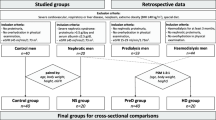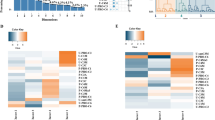Abstract
To assess the characteristics of connective tissue metabolism in chronic renal failure (CRF), urinary excretion of glycosaminoglycan (GAG) fractions and hydroxyproline (HYP) was determined in ten patients with CRF and in ten age-matched healthy children. CRF was found to be associated with elevated free HYP (19.9±6.1 vs 9.8±3.6 μmol/day,P<0.05) and depressed peptide HYP excretion (33.1±13.5 vs 225.2±17.7 μmol/day,P<0.01), a low rate of total GAG excretion (7.0±2.4 vs 16.1±1.9 μmol uronic acid/day,P<0.05) with low chondroitin 4 — sulphate + chondroitin 6 — sulphate (Ch-Ss) (14.0±9.9 vs 65.0±22.1%) and a high proportion of non-sulphated or under-sulphated fractions, i.e. hyaluronic acid + chondroitin + heparan sulphate (HA+Ch+HS) (75.3±11.4 vs 31.5±5.7%). Urinary 3-methyl-histidine (3-met-HIS) excretion and plasma essential free amino acids did not differ in the two groups. In response to haemodialysis no consistent change occurred in urinary excretion of 3-met-HIS, peptide-bound HYP, total GAG or percentage distribution of individual GAG fractions. After haemodialysis all plasma amino acids decreased significantly, and there was a significant increase in urinary excretion of free HYP (P<0.05). We conclude that the alterations in urinary excretion of total and individual GAGs observed in CRF may reflect disturbed connective tissue metabolism which does not appear to be accounted for by protein malnutrition or enhanced protein breakdown and remains uninfluenced by haemodialysis therapy.
Similar content being viewed by others
References
Dull TA, Henneman PH (1963) Urinary hydroxyproline as an index of collagen turnover in bone. N Engl J Med 268: 132–154
Prockop DJ (1964) Isotopic studies on collagen degradation and the urine excretion of hydroxyproline. J Clin Invest 43: 453–460
Avioli LV (1973) Collagen metabolism, uremia and bone. Kidney Int 4: 105–115
Hallgren R, Engström-Laurent A, Nisbeth U (1987) Circulating hyaluronate. A potential marker of altered metabolism of the connective tissue in uremia. Nephron 46: 150–154
Kivirikko KJ, Laitinen G, Prockop DJ (1967) Modifications of a specific assay for hydroxyproline in urine. Anal Biochem 19: 249–255
Radha E, Bessman SP (1982) A rapid colorimetric method for 3-methylhistidine in urine. Anal Biochem 121: 170–174
Tanaka Y, Gore I (1966) Cellulose column chromatography for the fractionation and isolation of acid mucopolysaccharides. J Chromatogr 23: 254–260
Davidson EA (1966) Analysis of sugars found in mucopolysaccharides. In: Colowich SP, Kaplan NO (eds) Methods in enzymology, vol VIII. Academic Press, New York, pp 52–60
Finlayson GR, Smith JG, Moore MJ, Sams WM (1963) elastosis and decreased urinary hydroxyproline in chronic acidosis. Fed Proc 22: 1620
Hahn TJ, Avioli LV (1970) Effect of chronic uremia on collagen metabolism in skin and bone. Arch Intern Med 126: 882–886
Kopple JD, Swendseid ME (1975) Protein and amino acid metabolism in uremic patients undergoing maintenance hemodialysis. Kidney Int [Suppl] 2: 64–72
Kopple JD (1978) Abnormal amino acid and protein metabolism in uremia. Kidney Int 14: 340–348
Bellard FJ, Tomas FM (1983) 3-Methylhistidine as a measure of skeletal muscle protein breakdown in human subjects: the care for its continued use. Clin Sci 65: 209–215
Klujber L, Sulyok E (1972) Urinary glycosaminoglycan excretion in normally grown and growth retarded neonates. I. Total glycosaminoglycan excretion. Acta Paediatr Acad Sci Hung 13: 81–87
Klujber L, Sulyok E (1973) Urinary glycosaminoglycan excretion in normally grown and growth retarded neonates. II. Quantitative distribution of glycosaminoglycans. Acta Paediatr Acad Sci Hung 14: 209–220
Straprans I, Garon SJ, Hopper J, Felts JM (1981) Characterization of glycosaminoglycans in urine from patients with nephrotic syndrome and control subjects, and their effects on lipoprotein lipase. Biochim Biophys Acta 678: 414–422
Cohen MP, Surma ML (1981)35S-Sulfate incorporation in-to glomerular basement membrane glycosaminoglycans is decreased in experimental diabetes. J Lab Clin Med 98: 715–722
Brown DM, Klein DJ, Michael AF, Oegeme TR (1982)35S-Glycosaminoglycan and35S-Glycopeptide metabolism by diabetic glomeruli and aorta. Diabetes 31: 185–188
Parthasarathy N, Spiro RG (1982) Effect of diabetes on the glycosaminoglycan component of the human glomerular basement membrane. Diabetes 31: 738–741
Shimomura H, Spiro RG (1987) Studies on macromolecular components of human glomerular basement membrane and alterations in diabetes. Decreased levels of heparan sulfate proteoglycan and laminin. Diabetes 36: 374–381
Kleppel MM, Kashtan CE, Butkowski RJ, Fish AJ, Michael AF (1987) Alport familial nephritis. Absence of 28 Kilodalton noncollagenous monomers of type IV collagen in glomerular basement membrane. J Clin Invest 80: 263–266
Schröder CH, Monnens LAH, Lith-Zanders HMA van, Trijbels JMF, Veerkamp JH (1987) The urinary excretion of total hydroxylysine and its glycosides contribution of the peptide-bound fraction. Nephron 47: 253–257
Fraser JRE, Laurent TC, Pertoft H, Baxter E (1981) Plasma clearance, tissue distribution and metabolism of hyaluronic acid injected intravenously in the rabbit. Biochem J 200: 415–424
Author information
Authors and Affiliations
Rights and permissions
About this article
Cite this article
Klujber, L., Turi, S., Haszon, I. et al. Connective tissue metabolism in children with chronic renal failure. Pediatr Nephrol 3, 179–185 (1989). https://doi.org/10.1007/BF00852905
Received:
Accepted:
Issue Date:
DOI: https://doi.org/10.1007/BF00852905




